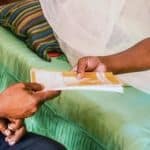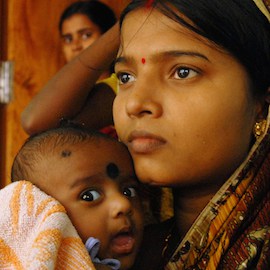A Roadmap that Bypasses the Public Health Care System
A year ago, I wrote about uber Diagnostics’ Cardiotrack, a 12-lead, network-connected, handheld electrocardiogram (ECG) monitor which was commercially launched in August 2015. Since then, based on customer feedback, we’ve enhanced Cardiotrack – we’ve extended its diagnostics capability by adding sensors and enhanced the Android software for easier collaboration between patients, doctors and specialists – and also refined our product “roadmap” based on difficulties encountered in India’s public health sector.
Cardiotrack – which displays the ECG waveform on an Android device via Bluetooth – is a rugged device that can withstand the tough environment of primary health care clinics in developing countries, where high temperature, high humidity and accidental drops are daily occurrences. Prior to the launch, the device had been tested extensively in the lab, at external test centers and at various hospitals in India and other countries.
We’ve deployed more than 150 Cardiotrack devices in India, Indonesia, Myanmar, Mexico and the U.S. In addition, product trials are under way in another eight countries. Of all the devices deployed to date, about 50 of them are being used actively and perform about one patient scan per day; the remaining devices average one scan per week or fewer. While we’ve been able to build strong working relationships with the active users, we’re trying to understand the reasons for low usage by the others.
The field data from the first year of deployment shows that we are saving lives through early diagnosis and intervention. The key question is, how can we accelerate the heart health screening process?
Our preferred location for such screening is at primary health care facilities. What we’ve learned is that private health care typically features fast decision-making and deployment, while public health care is much slower – in one instance, no deployment decision was made even after eight months of diligent effort on our part.
In India, a significant number of people receive health care services through public systems. Inability to deploy innovative solutions such as Cardiotrack in public health care means that a large percentage of the population is being deprived of the benefits of these technologies.
The problem is, initiatives by the political leaders to leverage public-private partnership (PPP) models to improve critical infrastructure in health care, sanitation and transportation are being stopped by India’s bureaucrats. Here are a couple of examples of the bureaucratic stranglehold and red tape.
In Bangalore, we met with the health minister and he endorsed initiatives like ours and asked his administrative assistant to explore ways to “pilot” such products in various health care centers. After numerous follow-ups with various public health administrators to run a small pilot to showcase the capability of our technology, public health officials decided against it. Someone with knowledge of the public health decision-making process informed us that deployment of such a solution would mean less revenue for private hospitals and clinics in the region, and the decision to not run a pilot maintained the status quo and kept the private clinic owners happy.
Also, a government agency in Andhra Pradesh invited us to Hyderabad for discussions. The action item was to identify which two clinics would host the first pilot of our technology. During the eight months since that meeting, we are still waiting to find out which clinics have been selected.
We realize that governmental agencies have lots of conflicting challenges. We are willing to do the “heavy lifting” as long as there is some support from the government. But governmental actions are driven by urgency – a couple of months ago the urgency was the heat wave, now it’s flooding due to monsoon and tomorrow it may be some other issues. These “urgencies” are mere excuses that governmental agencies and administrators use to deflect public scorn and justify their existence.
Health care is a booming business in India as can be seen from the rapid growth of private hospitals and clinics and related investment in the urban areas. This clearly shows need and demand. The inaction of health care planners to upgrade public health clinics continues to deprive two-thirds of the population of affordable and accessible health care. One health care expert declared public health clinics (PHC) in India as the place “where poor people go to die.”
After a long, frustrating period of trying to work with various public health organizations, we have abandoned the PPP model and created a public citizen partnership (PCP) model so that we can continue with our mission to save 1 million lives without the interference, red tape and apathy of the public health officials.
Heart Health for All campaign
One National Institutes of Health report indicates that in India, 1 in 5 people in the 40-and-older age group have a heart condition. In order to identify these patients, we need proper screening. The mission to save a million lives starts with screening 5 million people in this age group. We have been unable to reach the people through the public health care system, so we’ve bypassed it completely: We started the Heart Health for All campaign to install Cardiotrack ECG monitors and other critical health diagnostics devices in ambulances. Health demographic data from this campaign will be available for everyone to see and will help provide an accurate picture of the state of the public health care system.
These ambulances will travel to rural areas and provide free heart-health screening. We believe 250 ambulances fitted with the necessary equipment can screen 1.2 million patients in a year. This is the most cost-effective way to perform heart-health screening and provide valuable health demographic data that is not available today. Based on our analysis, a $1 million investment will result in a $100 million return on investment based on savings derived from avoidable health care costs and thousands of lives saved through timely intervention.
There are other benefits. An electronic medical record (EMR) will be created for everyone who participates in the free health screening. The EMR is provided to the patient, stored in their phone and securely saved in a cloud server. This portable EMR can be provided to a doctor during subsequent visits and new patient information may be added.
We are currently raising funds to install ECG monitors in 15-20 ambulances to test the idea and fine-tune the process for widespread deployment. This is not a purely philanthropic exercise on our part. It is a part of a strategic marketing initiative that uses crowdfunding as a means to reach a certain audience, find volunteers, build relationships with corporate social responsibility programs, create awareness about a critical health care problem and save lives. And this is being done with the help of grassroots philanthropists who are equally keen to bring about a change and help the underserved population.
Home health care
Our home health care program is designed to generate employment in urban areas. The purpose is to provide health care services at home for patients who want to avoid traffic and waiting for service at a doctor’s clinic. We train nurses and medical technicians on Cardiotrack ECG monitors and other diagnostics equipment.
Here’s how it works. A patient requests the service via a mobile app. A trained nurse or technician then goes to the patient’s home and performs a diagnosis. The nurse connects the patient with doctors and specialists, if needed, for next steps, and if the patient wants, their health record is sent electronically to the doctor. If an immediate phone consultation is required with a doctor, the nurse facilitates the consultation through the mobile app. The patient pays the nurse for the service, and part of the revenue generated is used to pay for the equipment rental and receive backend support.
Both of these initiatives are in the early stages of deployment. Early indicators are very encouraging. We believe that both of the initiatives fill in gaps in health care services at the primary care level. And, who knows, these innovative solutions may one day become the de facto solution for a better primary health care system that bypasses the public health care system completely.
Ashim Roy, co-founder of uber Diagnostics, is an entrepreneur with extensive knowledge about socioeconomic development in semi-urban and rural communities.
Photo, courtesy of uber Diagnostics, of the health diagnostic equipment being provided to select ambulances in India.
- Categories
- Health Care, Social Enterprise



